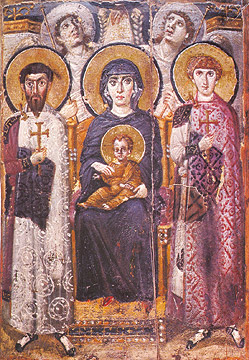Image Resource Bank
Image Gallery |  10 of 15
10 of 15 
Byzantine Icon of Virgin and Child, c. 600 CE
Many of the first Christians belonged to the Greek-speaking communities clustered around the eastern Mediterranean. The four Gospels and the other books of the New Testament were written in Greek, and in the following centuries, sophisticated liturgical and theological writings were produced in Greek. This Greek-speaking form of Christianity became the official faith of the Byzantine Empire, or Later Roman Empire, in the east. Constantinople (modern Istanbul) was the seat of the Greek patriarch and the capital of the Byzantine empire, which, until the rise of Islam in the seventh century CE, controlled the whole eastern Mediterranean world from Greece to Egypt. The Byzantines were fervent believers in the value of representational art to depict scenes from the Gospels and Old Testament; their churches were often decorated with figural mosaics and especially with icons, which served to educate and inspire the faithful. This icon from St. Catherine’s Monastery at the foot of Mt. Sinai, dated to about 600 CE, shows the Virgin Mary and infant Jesus flanked by Saints George and Theodore, with angels in the background. Its style is typical of Late Antique art, combining Hellenistic-Roman and Eastern features (see image 6).
Name: Virgin and Child with Angels and Sts. George and Theodore
Material: Encaustic on panel
Size: 69 cm (2 ft 2.5 in) x 48 cm (1 ft 6.84 in)
Date: ca. 600 CE
Place of Origin: Unknown
Location: St. Catherine's Monastery, Sinai
Registration # and Source:
Wikimedia Commons. Link to resource![]() (accessed April 27, 2010).
(accessed April 27, 2010).

 Fred M. Donner
Fred M. Donner
Professor of Near Eastern History, University of Chicago




